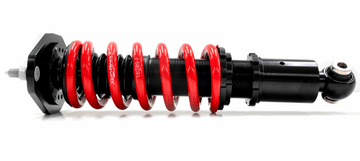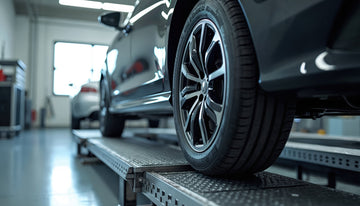Coilover spring rates refer to the stiffness or firmness of the springs used in your car's coilover suspension setup. Essentially, they determine how much resistance the springs provide when compressed or extended.
When it comes to your car's handling and overall performance, few factors are as crucial as the coilover spring rates. These rates determine how your vehicle responds to different road conditions, corners, and even your steering inputs.
It is important to understand your spring rates because optimising them can result in significant improvements in your car's handling, responsiveness, and stability. A properly matched set of springs can provide better traction, reduced body roll, enhanced cornering abilities, and improved overall balance. On the other hand, mismatched or improperly chosen spring rates can lead to a host of handling issues, such as excessive understeer or oversteer, unpredictable behaviour, and diminished control.
What types of spring rates are there?
When discussing coil springs, two terms commonly used are constant spring rate and variable spring rate. These terms refer to different characteristics of springs and play a significant role in how they behave under load.
Constant spring rate
A constant spring rate refers to a coil spring with a consistent rate of stiffness throughout its compression range. In other words, for every unit of load applied to the spring, the deflection or compression will be linear and uniform. This means that the spring rate remains constant regardless of the amount of load or the degree of compression.
This provides a predictable and consistent response to load, making it suitable for applications where consistent suspension behaviour is desired.
Variable spring rate
A variable spring rate refers to a coil spring that exhibits a non-linear or progressive rate of stiffness throughout its compression range. This means that the spring rate changes as the spring is compressed, becoming stiffer as more load is applied.
Variable spring rates are designed to provide different levels of resistance to compression depending on the degree of deflection. They typically have a softer initial rate that provides a comfortable ride during light loads and small bumps. As the spring compresses further, it transitions into a stiffer rate to handle larger impacts and maintain stability.
The purpose of a variable spring rate is to achieve a balance between ride comfort and performance. By providing a softer initial rate, the spring can absorb minor road imperfections and provide a smoother ride. As the spring compresses further, the stiffer rate provides increased support and control for more aggressive driving or heavier loads.
What are the factors that influence spring rates?
Coilover spring rates are influenced by various factors, each playing a role in determining the ideal stiffness for your vehicle's suspension. By understanding these factors, you can make informed decisions when selecting spring rates that best suit your vehicle and driving needs.
The factors that influence spring rates are;
Vehicle weight
The weight of your vehicle is a crucial consideration when determining spring rates. Heavier vehicles typically require stiffer springs to support the weight and maintain proper ride height. Lighter vehicles, on the other hand, can benefit from softer springs to achieve adequate suspension travel and ride comfort.
Suspension design
Different suspension designs, such as MacPherson struts, double wishbones, or multilink setups, can impact the required spring rates. The geometry and motion ratios of these designs affect how forces are transmitted through the suspension system, influencing the ideal stiffness needed for optimal performance and handling.
Intended use and driving style
The intended use of your vehicle and your driving style play a significant role in determining spring rates. Vehicles used for track racing or aggressive driving may require stiffer springs to enhance handling responsiveness and minimise body roll. Conversely, for a comfortable daily driver, softer springs can provide a smoother ride over various road surfaces.
Ride comfort vs. performance
Finding the balance between ride comfort and performance is essential. Stiffer springs offer improved performance, sharper handling, and reduced body roll, but may sacrifice some comfort. Softer springs, while providing a more comfortable ride, may result in increased body roll and reduced responsiveness. It's important to consider your priorities and strike a balance that suits your preferences.
Aftermarket modifications
Any aftermarket modifications made to your vehicle can impact the required spring rates. Alterations such as adding weight or changing suspension components can affect the overall dynamics and necessitate adjustments to spring rates for optimal performance.
Factors to Consider When Selecting Coilover Spring Rates for Your Vehicle
Selecting the right coil spring rate involves finding a balance between comfort, handling, and overall vehicle performance. Here are several key indicators to help you assess the adequacy of your coil spring rate selection:
Ride comfort
Consider the comfort level of your vehicle's ride. If the spring rate is too stiff, you may experience a harsh and jarring ride, feeling every bump and imperfection on the road. Conversely, if the spring rate is too soft, the vehicle may exhibit excessive body roll, wallowing, or bottoming out on bumps. The optimal spring stiffness is crucial in achieving a well-matched spring rate, striking the right balance between comfort and control for a smooth and controlled ride.
Handling and stability
Evaluate the handling characteristics of your vehicle. If the spring rate is too soft, you may experience excessive body roll during cornering, reduced stability, and imprecise steering response. On the other hand, if the spring rate is too stiff, the vehicle may exhibit a harsh and twitchy behaviour, reduced traction, and difficulty maintaining control. The right spring rate will provide the appropriate level of support and responsiveness, enhancing the vehicle's stability and handling performance.
Suspension response
Observe how your vehicle's suspension responds to various road conditions. If the spring rate is inadequate, you may notice excessive nosedive during braking, squatting during acceleration, or a lack of control over uneven surfaces. A suitable spring rate will help maintain proper suspension geometry and promote consistent contact between the tires and the road, resulting in improved overall suspension response.
Load handling
Consider the typical load and weight distribution of your vehicle. If you frequently carry heavy loads or have modifications that affect the weight distribution, ensure that the coil spring rate can adequately support the added weight. Insufficient spring rates may cause the vehicle to sag excessively or lead to imbalanced handling characteristics. It's important to choose spring rates that can handle the anticipated loads effectively.
Professional advice
Seek guidance from suspension specialists or professional technicians. Their expertise and experience in suspension tuning can provide valuable insights into the suitability of your current coil spring rate. They can evaluate your vehicle's characteristics, analyse its performance, and recommend adjustments or alternative spring rates based on your specific needs.
If you feel that your current spring rate is not adequately meeting your requirements or preferences, consider consulting with experts, conducting test drives, or exploring suspension tuning options to achieve the optimal balance for your vehicle.
Fine-Tuning Coilover Spring Rates: Tips and Tricks for Maximum Performance
By following these tips, you can fine-tune your spring rates and optimise your vehicle's handling and performance:
Test your vehicle under multiple conditions
When changing spring rates, it's crucial to perform comprehensive testing and evaluation. Take your vehicle for test drives under various conditions, such as different road surfaces, cornering, braking, and acceleration.
Pay attention to the car's handling characteristics, responsiveness, stability, and ride comfort. This hands-on experience will provide valuable insights into how the new spring rates affect your vehicle. Based on your observations, make note of any areas that need improvement or adjustments.
Make sure that your adjustments are gradual
Avoid making drastic changes to your spring rates all at once. Instead, adopt a systematic approach by making incremental adjustments. Increase or decrease the spring rates gradually, monitoring the vehicle's response and behaviour after each adjustment.
This gradual approach allows you to assess the impact of each change more accurately and make further adjustments as necessary. It helps you fine-tune the suspension without overwhelming the system or compromising overall performance.
Keep extensive records wherever possible
Maintain detailed records of your spring rate changes, driving impressions, and observed handling characteristics. This documentation serves as a valuable reference for future adjustments and comparisons.
By keeping records, you can track the progression of your suspension tuning efforts, identify patterns, and understand the cause and effect relationship between spring rates and vehicle performance. It also helps you avoid repeating unsuccessful adjustments and provides a basis for discussions with suspension specialists or technicians who can provide further guidance.
The Importance of Regularly Checking and Maintaining Your Coilover Spring Rates
- Importance of inspecting camber plates for signs of wear or damage
- Proper cleaning techniques to remove dirt and debris
- Importance of regular alignment checks to assess camber settings





